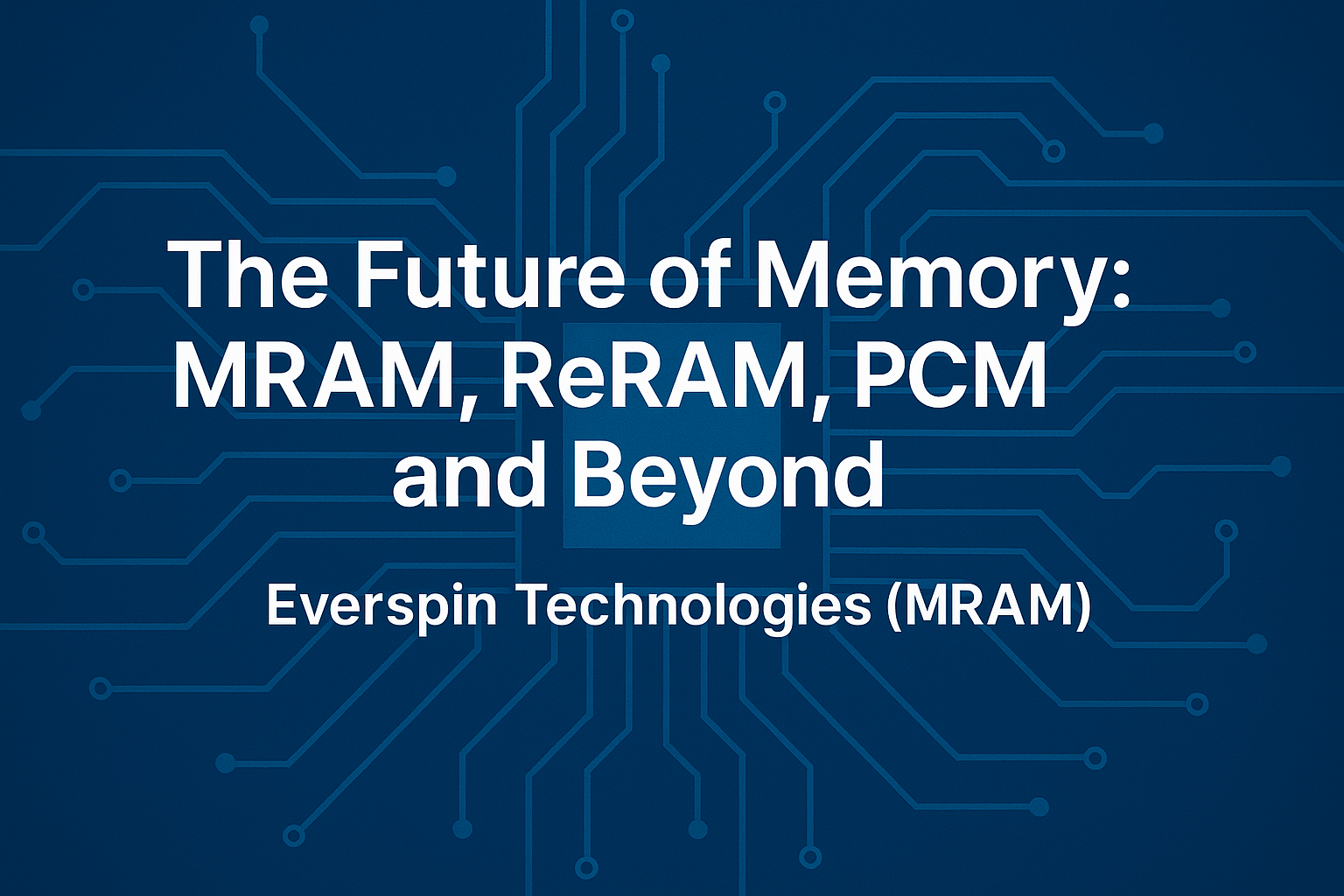
In the fast-evolving world of semiconductors, memory is once again at the center of innovation. While traditional DRAM and NAND Flash continue to dominate, a new generation of technologies is emerging to solve the twin challenges of speed and persistence. Among these, Magnetoresistive Random Access Memory (MRAM) — led by Everspin Technologies (NASDAQ: MRAM) — has quietly built a real business and a loyal following among engineers and investors alike.
What Comes After DRAM and Flash?
For decades, computing performance has been throttled by the “memory wall” — the lag between blazing-fast processors and slower, power-hungry memory. DRAM is fast but volatile. Flash is persistent but slow. Emerging technologies like MRAM, ReRAM (Resistive RAM), and PCM (Phase-Change Memory) aim to deliver the best of both worlds: non-volatile memory that operates at near-DRAM speeds, with higher endurance and lower power draw.
These innovations are not just theoretical. They’re becoming central to next-generation applications: data centers, aerospace, automotive systems, edge AI, and even defense electronics. Whoever wins the “memory race” could define the backbone of computing for the next decade.
Everspin Technologies: The MRAM Pioneer
Everspin Technologies stands out as the first and most visible pure-play MRAM company in the public markets. Founded on the premise that spintronics — the use of electron spin rather than charge — could revolutionize memory, Everspin has built commercial products around two main variants:
- Toggle MRAM: simple, fast, and durable, ideal for industrial and embedded systems.
- STT-MRAM (Spin Transfer Torque MRAM): higher density, scalable, and ready for data center and AI edge workloads.
While large chipmakers like Samsung and TSMC experiment with embedded MRAM, Everspin has already established real-world customers and revenue streams from mission-critical markets such as aerospace, defense, and industrial automation. Their radiation-hardened MRAM contracts underscore the company’s foothold in applications where failure is not an option.
Market Growth and Competitive Landscape
According to industry forecasts, the global MRAM market could grow from under $1 billion today to as much as $80 billion by 2034 — a staggering expansion driven by new device architectures and AI-centric hardware needs. Even more conservative projections show a steady 16%–35% CAGR.
Everspin currently addresses a total addressable market (TAM) of around $4.3 billion by 2029, focusing on high-reliability use cases rather than mass consumer memory. This niche strategy could pay off as defense and edge computing demand grows faster than traditional PC or mobile markets.
Meanwhile, competitors are rising fast:
- ReRAM (Resistive RAM) companies are pursuing ultra-low-power applications and AI accelerators.
- PCM (Phase-Change Memory) developers are exploring storage-class memory that bridges RAM and SSDs.
- Ferroelectric RAM (FeRAM) and Optane-class memories are pushing specialized niches.
Each contender has its strengths, but MRAM’s combination of speed, endurance, and true non-volatility has kept it in a leadership position, especially for systems where data integrity under stress is non-negotiable.
MRAM’s Financial Pulse: Everspin Stock Analysis
As of early October 2025, Everspin Technologies (MRAM) trades around $11.39 per share — up sharply from last year’s levels. While the market cap remains modest, the company’s fundamentals tell a nuanced story:
- 2024 revenue of approximately $50 million, down 21% year-over-year due to cyclical softness.
- Maintained profitability despite volatility, highlighting operational discipline.
- Secured multi-million-dollar government contracts to supply radiation-hardened MRAM for aerospace and defense.
- Analyst price targets range from $8 to $10, with consensus labeling it a “Moderate Buy.”
- Gross margins remain healthy, reflecting limited competition in niche MRAM segments.
On a relative basis, MRAM stock has outperformed the U.S. semiconductor index over the past year, thanks to enthusiasm around its unique position as the only pure-play MRAM provider on the Nasdaq. Still, the stock’s future performance hinges on one question: can MRAM adoption grow fast enough to offset cyclical semiconductor headwinds?
Risks and Reality Checks
Like any moonshot technology, MRAM faces challenges:
- Adoption risk — major customers may hesitate to switch from cheaper, well-known DRAM or Flash solutions.
- Cost scaling — MRAM must continue reducing fabrication costs to gain mass-market traction.
- Dependence on contracts — a meaningful portion of revenue still stems from government or defense projects.
- Competition — new ReRAM and PCM startups could undercut MRAM’s cost or performance edge in certain applications.
Everspin’s small scale also amplifies volatility; one missed contract or slow product ramp can move the stock dramatically. However, the same small size means that even a few new design wins could materially boost earnings and investor sentiment.
Catalysts and the Road Ahead
The next phase for Everspin — and MRAM more broadly — depends on three critical catalysts:
- Broader adoption of STT-MRAM in AI edge and industrial IoT systems where speed and persistence matter.
- Integration into major SoCs and FPGAs via foundry partnerships, bringing MRAM closer to mainstream chip architectures.
- Expansion of U.S. semiconductor incentives under CHIPS Act initiatives that could fund domestic MRAM production.
Should these align, Everspin’s niche could evolve into a genuine leadership position in the next-generation memory hierarchy — the bridge between DRAM and Flash that engineers have dreamed of for decades.
Conclusion: Betting on the Future of Memory
The memory market’s next era will not be defined by one technology alone. MRAM, ReRAM, and PCM each offer distinct advantages, and together they are reshaping how data is stored, accessed, and preserved.
For investors, Everspin Technologies (MRAM) represents both risk and rare opportunity — a small-cap innovator at the forefront of a technology that could redefine the semiconductor landscape. Its focus on aerospace, edge AI, and mission-critical memory gives it resilience and differentiation in a crowded chip industry.
Whether MRAM ultimately becomes the dominant next-generation memory or one vital piece of a larger ecosystem, its progress is worth watching — and possibly investing in — as computing pushes beyond the limits of traditional silicon.
Disclosure: This article is for informational purposes only and does not constitute financial advice. Always conduct your own due diligence or consult a financial advisor before investing.




Be the first to comment